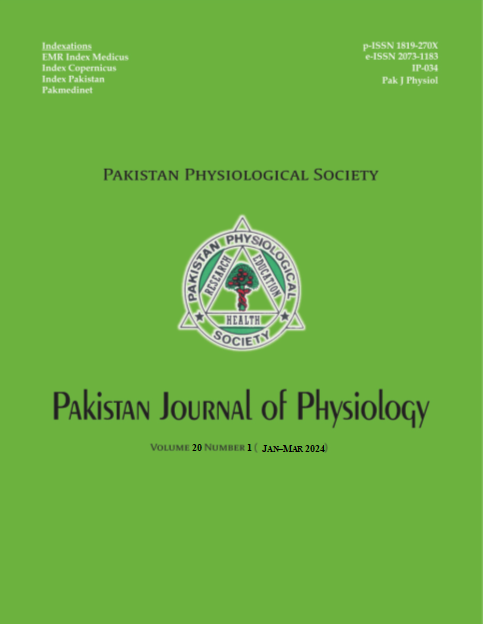ANTI-MÜLLERIAN HORMONE: A BETTER BIO MARKER FOR ASSESSMENT OF ANOVULATION IN POLYCYSTIC OVARIAN SYNDROME COMPARED TO CONVENTIONAL BIOMARKERS
DOI:
https://doi.org/10.69656/pjp.v20i1.1598Keywords:
Anti-Mullerian hormone, Polycystic ovarian syndrome, SensitivityAbstract
Background: Polycystic Ovary Syndrome (PCOS) is a common endocrine disorder affecting women of childbearing age. The objective of this study was to determine the diagnostic accuracy of Anti-Müllerian Hormone (AMH) in predicting anovulatory PCOS, keeping day 21 progesterone level as gold standard. Methods: This cross-sectional validation study was conducted on 289 women aged 15–30 years with PCOS, from 11 Aug 2021 to 10 Feb 2022, in Pathology Department, Bahawal Victoria Hospital, Bahawalpur. AMH levels were measured and anovulatory events documented. AMH levels were compared with progesterone levels on the 21st day of the menstrual cycle. Results: In the cohort of individuals demonstrating a positive presence of AMH, a total of 149 were accurately identified as true positives, while 6 were mistakenly classified as false positives. Within the group of patients exhibiting a negative status for AMH, 8 were incorrectly categorized as false negatives, whereas 126 were correctly identified as true negatives. When evaluating the diagnostic efficacy of AMH as a predictor of anovulatory PCOS, with the 21st day progesterone measurement, the following metrics were ascertained: a commendable sensitivity of 94.90%, a robust specificity of 95.45%, a notable positive predictive value of 96.13%, a substantial negative predictive value of 94.03%, and an impressive overall diagnostic accuracy of 95.16%. Conclusion: The diagnostic accuracy of Anti-Müllerian hormone in predicting anovulatory PCOS is very high.
Pak J Physiol 2024;20(1):8-11
Downloads
References
Michelmore KF, Balen AH, Dunger DB, Vessey MP. Polycystic ovaries and associated clinical and biochemical features in young women. Clin Endocrinol 1999;51(6):779–86.
Koivunen R, Laatikainen T, Tomas C, Huhtaniemi I, Tapanainen J, Marti-kainen H. The prevalence of polycystic ovaries in healthy women. Acta Obstet Gynecol Scand 1999;78(2):137–41.
Akram M, Roohi N. Endocrine correlates of polycystic ovary syndrome in Pakistani women. J Coll Physicians Surg Pak 2015;25(1):22–6.
Stein IF, Leventhal ML. Amenorrhea is associated with bilateral polycys- tic ovaries. Am J Obstet Gynecol 1935;29(2):181–91.
Sobti S, Dewan R, Ranga S. Metabolic syndrome and insulin resistance in PCOS phenotypes. Int J Reprod Contracept Obstet Gynecol 2017;6(11):5067–73.
Dunaif A, Segal KR, Futterweit W, Dobrjansky A. Profound peripheral insulin resistance, independent of obesity, in polycystic ovary syndrome. Diabetes 1989;38(9):1165–74.
Di Paola R, Garzon S, Giuliani S, Laganà AS, Noventa M, Parissone F, et al. Are we choosing the correct FSH starting dose during controlled ovarian stimulation for intrauterine insemination cycles? Potential application of a nomogram based on woman’s age and markers of ovarian reserve. Arch Gynecol Obstet 2018;298(5):1029–35.
Dewailly D, Gronier H, Poncelet E, Robin G, Leroy M, Pigny P, et al. Diagnosis of polycystic ovary syndrome (PCOS): revisiting the threshold values of follicle count on ultrasound and of the serum AMH level for the definition of polycystic ovaries. Hum Reprod 2011;26(11):3123–9.
Weerakiet S, Lertvikool S, Tingthanatikul Y, Wansumrith S, Leelaphiwat S, Jultanmas R. Ovarian reserve in women with polycystic ovary syndrome who underwent laparoscopic ovarian drilling. Gynecol Endocrinol 2007;23(8):455–60.
Begawy AF, El-Mazny AN, Abou-Salem NA, El-Taweel NE. Anti-Müllerian hormone in polycystic ovary syndrome and normo-ovulatory women: correlation with clinical, hormonal and ultrasonographic parameters. Middle East Fertil Soc J 2010;15(4):253–8.
Pigny P, Jonard S, Robert Y, Dewailly D. Serum anti-Müllerian hormone as a surrogate for antral follicle count for definition of the polycystic ovary syndrome. J Clin Endocrinol Metab 2006;91:941–5.
Lin YH, Chiu WC, Wu CH, Tzeng CR, Sen Hsu C, Hsu MI. Anti-Müllerian hormone and polycystic ovary syndrome. Fertil Steril 2011;96(1):230–5.
Butt MS, Saleem J, Aiman S. Zakar R, Sadique I, Fischer F. Serum anti-Müllerian hormone as a predictor of polycystic ovarian syndrome among women of reproductive age. BMC Women’s Health 2022;22:199.
Eilertsen TB, Vanky E, Carlsen SM. Anti-Müllerian hormone in the diagnosis of polycystic ovary syndrome: can morphologic description be replaced? Hum Reprod 2012;27(8):2494–502.
Iliodromiti S, Kelsey TW, Anderson RA, Nelson SM. Can anti-Müllerian hormone predict the diagnosis of polycystic ovary syndrome? A systematic review and meta-analysis of extracted data. J Clin Endocrinol Metab 2013;98(8):3332–40.
Tenajas R, Miraut D, Illana CI, Alonso-Gonzalez R, Arias-Valcayo F, Herraiz JL. Recent advances in artificial intelligence-assisted ultrasound scanning. Appl Sci 2023;13(6):3693.
Dewailly D, Alebic MS, Duhamel A, Stojanovic N. Using cluster analysis to identify a homogeneous subpopulation of women with polycystic ovarian morphology in a population of non-hyperandrogenic women with regular menstrual cycles. Hum Reprod 2014;29(11):2536–43.
Dewailly D, Lujan ME, Carmina E, Cedars MI, Laven J, Norman RJ, et al. Definition and significance of polycystic ovarian morphology: a task force report from the Androgen Excess and Polycystic Ovary Syndrome Society. Hum Reprod Update 2014;20(3):334–52.
Asada Y, Tsuiki M, Sonohara M, Fukunaga N, Hattori Y, Inoue D, et al. Performance of anti-Müllerian hormone (AMH) levels measured by Beckman Coulter Access AMH assay to predict oocyte yield following controlled ovarian stimulation for in vitro fertilization. Reprod Med Biol 2019;18(3):273–7.
Tadros T, Tarasconi B, Nassar J, Benhaim JL, Taieb J, Fanchin R. New automated antimüllerian hormone assays are more reliable than the manual assay in patients with reduced antral follicle count. Fertil Steril 2016;106(7):1800–6.
Sivanandy MS, Ha SK. The role of serum Anti-Müllerian hormone measurement in the diagnosis of polycystic ovary syndrome. Diagnostics (Basel) 2023;13(5):907.
Tal R, Seifer CM, Khanimov M. Seifer DB, Tal O. High serum Antimüllerian hormone levels are associated with lower live birth rates in women with polycystic ovarian syndrome undergoing assisted reproductive technology. Reprod Biol Endocrinol 2020;18(1):20.
Downloads
Published
How to Cite
Issue
Section
License

This work is licensed under a Creative Commons Attribution-NoDerivatives 4.0 International License.
The author(s) retain the copyrights and allow their publication in Pakistan Journal of Physiology, Pak J Physiol, PJP to be FREE for research and academic purposes. It can be downloaded and stored, printed, presented, projected, cited and quoted with full reference of, and acknowledgement to the author(s) and the PJP. The contents are published with an international CC-BY-ND-4.0 License.











